
Bulbs may not be magic, but they come pretty close. These small, dry plant pieces are actually carefully packed flower kits from Mother Nature. Each contains everything a plant needs to start growing in your garden bed: sprout, leaf, flower, and die back. Most will reappear year after year.
If you are ready to start a bulb garden, don't get confused by all the different sizes and shapes of bulbs or the many confusing instructions you might find on the internet regarding planting. It's not that complicated. We've set out everything you need to know to get started planting bulbs, and we follow up with how-to-plant instructions for the most popular types of bulbs.
Video of the Day
Video of the Day
Bulb Basics
Bulbs add so much to a garden. You plant them, water them, and watch their flowers appear in bright colors to liven up the garden. The "bulb battery" has to be recharged by photosynthesis to work its magic the following year. We use the term "bulb" to include many underground roots that have different botanical names but are, for all intents and purposes, in the same family, like tubers, corms, and rhizomes.
The range of flowers that grow from bulbs is dazzling. Some are a few inches tall, while others rise to 2 or 3 feet or taller. Many come in vibrant shades, and more than a few offer fragrance as well as color and charm. Plantings that mix colors and shapes of flowers are lovely, but groups of the same species can be stunning too.
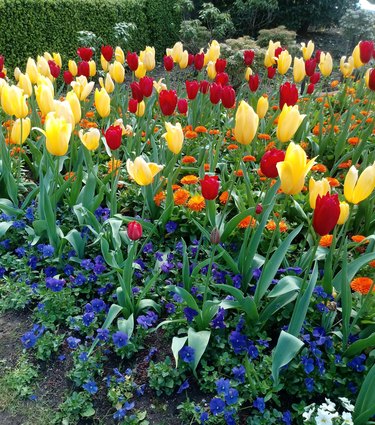
Spring, Summer, or Fall Planting?
Bulbs bloom at a specific time of year. Spring-blooming bulbs might be the most popular, with gardeners around the world planting daffodils, tulips, hyacinths, and crocus. But other bulbs bloom in summer—think lilies, gladiolus, and dahlias. And a few lilies and crocus varieties start in summer but light up the autumn garden too.
Though the timing on planting differs among these three groups, all the other "how-to-plant" details are the same.
Bloom seasons
Spring | Summer | Fall |
|---|---|---|
Allium | Asiatic lily | Autumn crocus |
Crocus | Calla lily | Climbing lily |
Daffodil | Canna | Gloriosa lily |
Grape hyacinth | Dahlia | Lily-of-the-Nile |
Hyacinth | Gladiolus | Peacock orchids |
Snowdrop | Elephant ear | Rain lily |
Tulip | Tuberose |
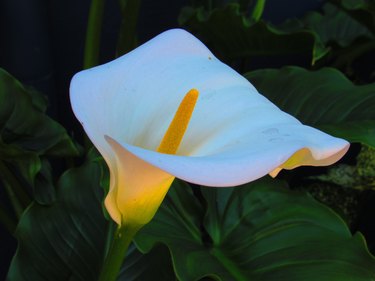
When to Plant Bulbs
You can find intricate charts online regarding when to plant bulbs in each of the 13 different hardiness zones, but that may be more information than an average gardener needs. What you need to know is your first fall frost date and last spring frost date.
For spring-blooming bulbs, plant four to six weeks before the fall frost date. The idea is to plant sufficiently before the cold weather to allow the bulbs to drop roots but not enough to encourage them to sprout.
For summer-blooming bulbs, plant in early to mid spring after the final spring frost. The weather should be consistently warm.
For fall-blooming bulbs, it depends on the bulbs. Fall-blooming lily bulbs should be planted in spring at the same time as summer-blooming bulbs. Plant other fall-blooming bulbs after the heat of the summer has passed.
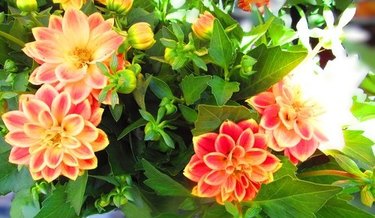
Bulb Planting Made Simple
In addition to planting at the right time, there are two golden rules for planting bulbs successfully: Prepare the soil well and plant to the right depth.
You can plant bulbs in containers, raised beds, or right in the soil, but keep in mind that bulbs are perennials that require sun. Plant in an area that gets at least six hours of direct sun.
Preparing the Soil
Bulbs need a site with excellent drainage since they rot in wet soil. Soil can be sandy or loamy with a neutral pH. Keep your bulb plants away from driveways if you use road salt in the winter.
Preparing the soil is important. Remove tough weeds and large rocks in the bulb-planting area. Then work the soil to at least 6 inches to give the bulb roots easy access. Once the soil is worked, spread an inch or two of organic compost over the entire planting area and work it into the top few inches.

Planting the Bulbs
Bulb sizes differ, but no matter the size, every bulb should be planted at a depth of between two and three times its height. That means that if a bulb is 2 inches high, you should dig a hole between 4 and 6 inches deep. There are special bulb-planting tools you can buy to dig the holes, but a trowel with a scoop-shaped blade works fine.
Get the bulb planted with the right side up. The pointed side goes up, and the flat, root-producing side goes down. Once the bulbs are in, water them to get them rooting right away. Spread a layer of mulch on top and mark the area as planted.
Layered Planting
There's a trending bulb placement option making the rounds on the internet with the catchy name "lasagna planting." It mixes different types of bulbs in one space in layers so that a mix of flowers grow and bloom for a longer period. The biggest bulbs and those that bloom latest are planted lowest in the soil, followed by the medium-size bulbs and the small spring-blooming bulbs on top.
Tulip Bulbs
Tulips are worldwide favorites when it comes to spring-flowering bulb plants, and they blaze in almost every color of the rainbow in April and May. Most tulip varieties have stems that may grow to 2 feet tall topped by one cup-shaped blossom.

When to plant tulip bulbs
Plant tulip bulbs in the fall between September and November. The warmer your hardiness zone, the longer you can push the planting date. All tulips require the winter cold to bloom: 12 to 14 weeks of temperatures below 55 degrees Fahrenheit. In warm-winter regions, buy prechilled bulbs.
How to plant tulip bulbs
Tulip buds are between 2 and 3 inches tall, so you'll need to plant them between 6 and 9 inches deep. They grow best in a full-sun location and in soil with excellent drainage. The flowers dazzle in a group of 10 or more, but leave some space between them—at least 4 inches—since each plant fills out. Plant with the flat end down and the pointed end up.
Tulips are among the minority of bulbs that do not come back year after year. You can buy hybrids that rebloom, but ordinary tulip bulbs can be dug up and tossed after one glorious spring.
Daffodil Bulbs
Are daffodils the most popular of the spring bulb flowers? That would be my guess. It's easy to understand daffodil fans once you've seen their bright, happy blossoms. The stalks can grow 24 to 30 inches tall, topped with yellow or golden blossoms. They look stunning in a planter or when filling a field.
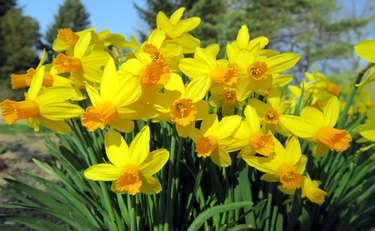
When to plant daffodil bulbs
The epitome of spring bulbs, daffodils are planted in the fall. Plant them in late September or early October at the latest. You can push that farther back in warm-winter regions. They flower in March, April, and May.
How to plant daffodil bulbs
Plant daffodils in a full-sun area in well-draining soil. Dig holes for the bulbs some 4 to 6 inches deep depending on the size of the bulbs, and don't forget that the pointed end must be up. Space them 5 inches apart for the most immediate impact but up to 12 inches apart if you intend to naturalize them. Over the years, the plants will fill in the area between them.
Elephant Ear Bulbs
Did I say all bulbs develop into bright flowers? An elephant ear bulb is the exception that proves the rule. These tropical perennials (USDA hardiness zones 10-11) are grown for their lush, large leaves with bold patterning. The shape of the leaves resembles the ears of—you guessed it—elephants.
But that's not the only "bulb rule" these plants break. They like dappled sun, not full sun like other bulbs, and they prefer moist soil. There are dozens of varieties with different dimensions and leaf patterns.
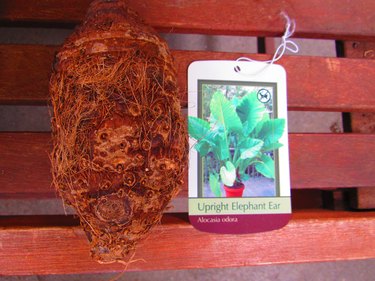
When to plant elephant ear bulbs
These bulbs should be planted in late spring or summer once all chance of cold weather has passed. If you have a soil thermometer, wait until the soil temperatures reach 70° F.
Recall that these are tropical bulbs that only live through the winter (to bloom again the following year) in the warmest hardiness zones. Elsewhere, they can be grown as annuals or brought inside for winter.
How to plant elephant ear bulbs
Plant elephant ear bulbs about 4-6 inches deep, spacing them between 2 and 4 feet apart depending on the mature size of the variety. They need feeding too. Use a balanced fertilizer like 20-20-20 twice a month during the growing season.
Gladiolus Bulbs
Gladiolus are classic cutting flowers and a star of summer flower bouquets. But their tall spikes of colorful flowers also add life to the garden. Perennials in USDA zones 8 and above, gladiolus bulbs are as easy to plant as the flowers are to love. Common gladiolus grow 2 and 5 feet tall, and the tallest kinds need staking.

When to plant gladiolus bulbs
Gladiolus don't like cold soil, so you'll want to wait to plant these corms until all possibility of spring frost is history. Check the temperature of the soil to be sure it is 55° F or warmer before putting the bulbs in place.
How to plant gladiolus bulbs
Gladiolus are tall plants with deep roots, so be sure you have worked the soil to a depth of a foot or more. Blend in a few inches of organic compost and then prepare holes that are 4 inches deep. Set a corm in each hole, flat end down and pointed end up. Then, cover with soil. Space the corms at least 6 inches apart. After planting, add a 2 to 4-inch layer of mulch and water well. If you are planting tall varieties, now is the time to install stakes.
Iris Bulbs
One of the most popular spring-blooming bulbs is iris. There are hundreds of species, but most can be recognized by their sword-shaped leaves and distinctive six-petaled flowers with three outer hanging petals and three inner upright petals. The iris comes in so many colors that we lost count. Heights also vary, and some iris stems grow to 40 inches tall. They are very hardy.
A few types of iris grow from bulbs. Most, however, grow from rhizomes, fleshy root pieces that act like bulbs, storing nutrients for the plant.
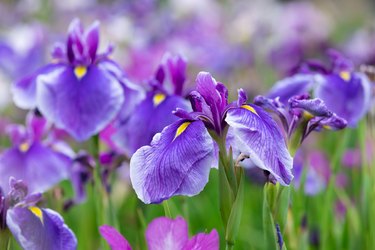
When to plant iris bulbs
The general rule is to plant irises in late summer to early fall. Ideally, the night temperatures at planting will be between 40 and 50° F so that the bulbs or rhizomes have sufficient time to drop roots before winter. If you are planting taller species like the bearded iris, push the planting date until fall.
How to plant iris bulbs
Irises require direct sun and a lot of it to bloom, so select a spot with lots of rays. The soil should be well-draining and amended with compost before planting.
To plant iris bulbs, plant the bulb pointy end up in a 5-inch-deep hole for bulbs and place the bulb in the hole with the pointy end up. Plant the individual bulbs at least 4 inches apart. Cover the bulb and water.
For an iris grown from a rhizome, prepare a space some 4-5 inches deep. Stand the rhizome up vertically on a small ridge, placed so that the top of the rhizome is above the soil level. The iris roots should be spread out on all sides. Fill in with soil and water.
Dahlia Bulbs
Dahlias are show-boat flowers that remind me of exploding fireworks. They come in a wide variety of sizes, colors, and forms, from low plants perfect for borders to huge flowers sitting pretty atop stems taller than you are.
Like most bulb plants, dahlias need full sun and well-draining soil. They will reward you with a spectacular display from mid summer through the first frost and then return year after year in USDA hardiness zones 8 and above.

When to plant dahlia bulbs
Dahlias are truly gorgeous flowers, but they do not like cold soil. Wait until the last spring frost is in the rear-view mirror to plant dahlia bulbs, ideally when the soil temperature has reached 60 degrees. This generally translates to planting in late spring. The bulbs are perennials in USDA zone 6 and above and must be treated as annuals in colder areas.
How to plant dahlia bulbs
Dahlias come in large, medium, and small sizes, but truly small dahlias are grown from seeds, not bulbs. Large and medium dahlias are grown from bulbs. Segregate large dahlias in a plot of their own, planting the bulbs about 3 feet apart. Medium bulbs can be mixed in with other summer bulbs some 2 feet apart.
Dig holes between 6 and 8 inches deep, tossing some bonemeal into each planting hole. Be sure to set the tubers into the holes with the growing points facing up. Top with a few inches of soil.
Do not water the bulbs until sprouts appear. As the stems grow, add more soil, continuing this until the soil is at ground level. Use no mulch for these plants that love sun on their roots.